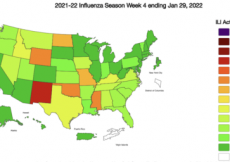A study currently available on the medRxiv* preprint server has demonstrated that the incidence and mortality rates of coronavirus disease 2019 (COVID-19) in the US can be significantly reduced at the population level by increasing vaccinate rates from 40% to 80%. An increased vaccination rate has a protective effect on the entire population, not just among vaccinated people.
Background
The COVID-19 pandemic caused by severe acute respiratory syndrome coronavirus 2 (SARS-CoV-2) has significantly affected many countries’ economies and healthcare systems, with more than 256 million infections and over 5.1 million deaths recorded globally. The highest incidence and mortality have been observed in the US, with over 47 million infections and more than 768,000 deaths as of 19th November 2021.
The mass vaccination campaign in the US includes three vaccines, namely BNT162b2 (Pfizer/BioNTech), mRNA 1273 (Moderna), and JNJ-78436735 (Janssen Pharmaceuticals). All these vaccines have shown high efficacy in preventing SARS-CoV-2 infection, symptomatic COVID-19, hospitalization, and death.
Despite high vaccine efficacy, a significant proportion of the US population, especially minorities, is unvaccinated because of vaccine hesitancy. Such reduction in vaccine coverage may affect the possibility of reaching herd immunity and increase the incidence and mortality of COVID-19 at the population level.
In the current study, the scientists from the UCLA Fielding School of Public Health, the International Vaccine Institute, the UCLA Fielding School of Public Health, and the UCLA School of Medicine have investigated whether the community-wide spread of COVID-19 and related mortality can be prevented by increasing the vaccination rate.
Study design
The study investigated the correlation between county-level vaccination rates and COVID-19 incidence and mortality using negative binomial models. The COVID-19 incidence and mortality data were obtained from the Center for Systems Science and Engineering Coronavirus Resource Center, Johns Hopkins University.
The study included a total of 3,070 counties across 49 US states, and the data was collected between April and September 2021. In addition, the study included the time period when the delta variant of SARS-CoV-2 became predominant in the US (July – September 2021).
A two-week interval between vaccination and full-protection was considered to assess the effect of vaccination rate on COVID-19 incidence. Similarly, a four-week interval was introduced to assess the impact of vaccination rate on COVID-19 mortality.
Important observations
In 3,070 counties included in the analysis, the average vaccination rate at the population level was 42%. Compared to counties with less than 40% vaccination rates, counties with more than 40% vaccination rates had higher numbers of hospital beds, higher socioeconomic status, higher population density, and lower uninsured population.
Overall, the study findings revealed that the county-wide COVID-19 incidence and mortality could be reduced by 0.9% and 1.8%, respectively, by simply increasing the county-level vaccination rate by 1%.
A separate set of analyses was conducted with the data obtained between July and September 2021, when the delta variant was predominant in the US. The findings identified a positive association between county-level vaccination rate and protection against COVID-19.
Counties with more than 40% vaccine coverage
A total of 1,686 counties were identified to have vaccination rates of more than 40%. In these counties, an increase in vaccination rate by 1% was found to reduce COVID-19 incidence and mortality by 1.5% and 2.7%, respectively.
In contrast, no association between induction in vaccination rate and reduction in COVID-19 incidence and mortality was observed in counties with less than 40% vaccine coverage.
The sensitivity analysis conducted to assess the impact of a 10% incremental increase in vaccination rate revealed that 45% of COVID-19 cases and 67% of COVID-19-related deaths could have been prevented by increasing county-level vaccination rates from 40% to 80%.
Considering the US population at risk, an estimated 5,989,952 COVID-19 cases and 127,596 deaths could have been prevented by increasing the vaccination rate from 40% to 80%.
Study significance
The study highlights the importance of COVID-19 vaccination in reducing the rates of SARS-CoV-2 infection and related mortality. Specifically, the study findings reveal that in the US, a significant level of protection against COVID-19 can be achieved by attaining a county-level vaccination rate of 80%.
These findings indicate that a high vaccine coverage could provide population-wide protection against COVID-19 even when a considerable fraction of the population remains unvaccinated due to vaccine hesitancy.
*Important Notice
medRxiv publishes preliminary scientific reports that are not peer-reviewed and, therefore, should not be regarded as conclusive, guide clinical practice/health-related behavior, or treated as established information.



































